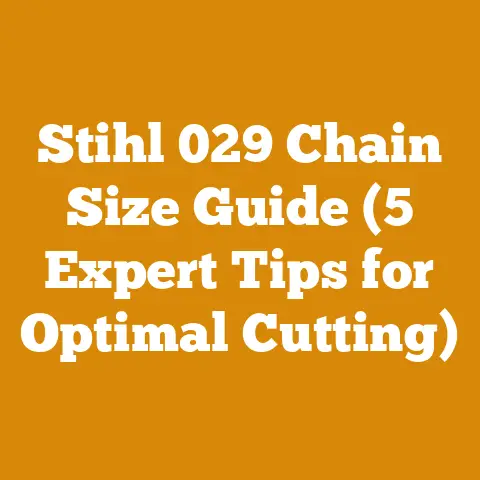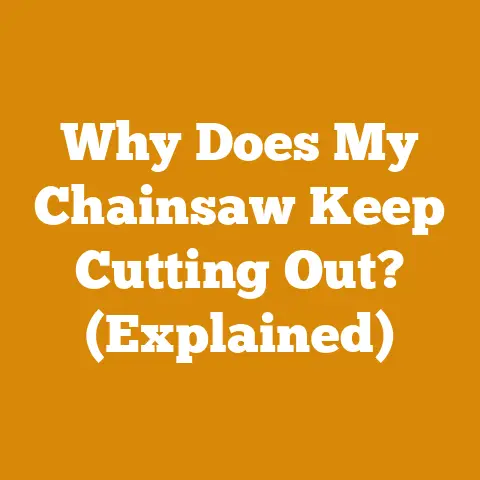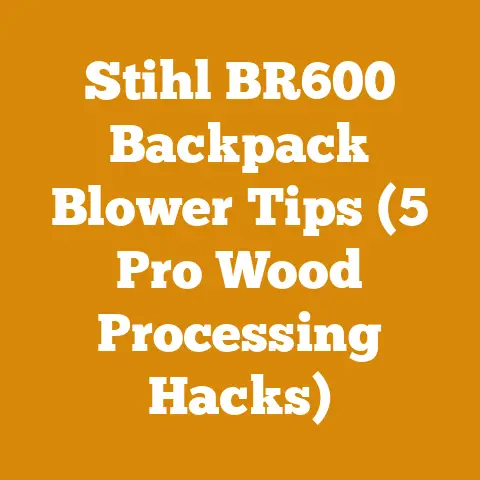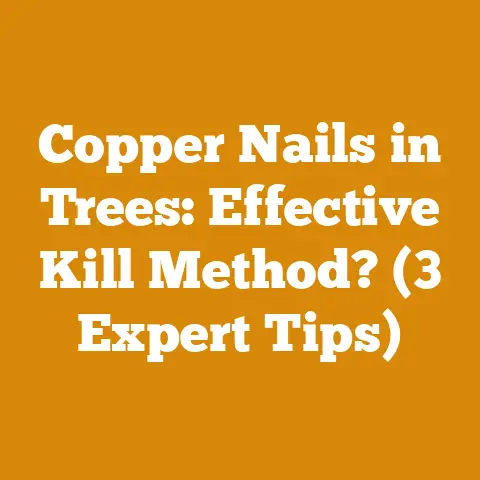Husqvarna Weed Eater Blade Attachment Compatibility (Pro Tips)
Ever felt like your Husqvarna weed eater was just scratching the surface of what it could do? Like it was a race car stuck in first gear? I get it. You’ve got this powerful tool, but you’re limited to trimming grass. The thought of tackling thicker brush, saplings, or even small trees with a blade attachment is tempting, but the compatibility question looms large: “Will this blade actually work with my Husqvarna weed eater?” That’s the challenge I’m going to help you navigate today.
I’ve spent years in the wood processing and land clearing game, from felling trees with a chainsaw to prepping firewood for the long winter months. I’ve also tinkered with countless pieces of equipment, including weed eaters. So believe me, I understand the frustration of wanting to maximize the utility of your tools. Let’s dive into the world of Husqvarna weed eater blade attachment compatibility, unlocking the true potential of your machine.
Husqvarna Weed Eater Blade Attachment Compatibility: Pro Tips
Understanding the Core Compatibility Factors
The first step is understanding why some blades work and others don’t. It’s not just about slapping any old blade on there and hoping for the best. We need to consider a few key factors:
- Arbor Size: This is the diameter of the hole in the center of the blade. The arbor size on the blade needs to match the spindle size on your Husqvarna weed eater. If they don’t align, the blade won’t fit securely, leading to vibration, potential damage to the machine, and, most importantly, safety hazards.
- Shaft Type: Husqvarna weed eaters come in two main types: straight shaft and curved shaft. Straight shaft models are generally better suited for blade attachments due to their increased power and durability. Curved shaft models are often less robust and may not handle the stress of a blade.
- Engine Size (CC): The cubic centimeters (CC) of your engine is crucial. A larger engine provides more power, which is necessary for spinning a blade through thick vegetation. Trying to use a blade attachment on a weed eater with a small engine is like trying to tow a trailer with a bicycle – it’s not going to end well.
- Guard Compatibility: The guard on your weed eater is designed to protect you from flying debris. When using a blade attachment, you need to ensure the guard is appropriate for the blade size and type. A smaller guard might not provide adequate protection, increasing the risk of injury.
- Weight and Balance: Adding a blade attachment changes the weight and balance of your weed eater. This can affect handling and fatigue. You need to be comfortable and in control while using the machine.
Decoding Husqvarna Weed Eater Models
Husqvarna offers a wide range of weed eaters, each with its own specifications and capabilities. Understanding your specific model is paramount. Here’s a breakdown of common Husqvarna weed eater types and their blade attachment compatibility:
- Light-Duty Models (e.g., 128LD, 129LK): These are typically designed for trimming grass and light weeds. While some may be technically compatible with small, lightweight blades, I generally advise against it. The engine size is often too small to handle the stress, and the shaft may not be robust enough. Think of these as your go-to for maintaining a manicured lawn, not for clearing a jungle.
- Mid-Range Models (e.g., 324L, 525LST): These models offer a good balance of power and maneuverability. They are often compatible with brush cutter blades, but it’s crucial to check the manufacturer’s specifications. These are your workhorses, capable of handling tougher tasks but still relatively lightweight.
- Heavy-Duty Models (e.g., 545RXT, 555RXT): These are the beasts of the Husqvarna weed eater lineup. They are designed for demanding tasks and are typically compatible with a wide range of blade attachments, including brush cutter blades, saw blades, and even some clearing saw blades. These are your heavy hitters, built for tackling the toughest vegetation.
How to Find Your Model Number
Your Husqvarna weed eater’s model number is usually located on a sticker or plate on the engine housing or shaft. Once you have the model number, you can consult the owner’s manual or the Husqvarna website to determine its specifications and recommended blade attachments.
- Brush Cutter Blades: These are the most common type of blade attachment for weed eaters. They typically have 2 to 8 teeth and are designed for cutting through thick grass, weeds, and small brush. They are a versatile option for general clearing tasks.
- Example: A 4-tooth brush cutter blade is a good all-around choice for tackling thick weeds and small saplings.
- Saw Blades: These blades have numerous teeth and are designed for cutting through small trees and branches. They are more aggressive than brush cutter blades and require more power. These are your go-to for cutting woody material.
- Example: An 80-tooth saw blade can be used to cut through branches up to 2 inches in diameter.
- Clearing Saw Blades: These are larger and more aggressive than saw blades. They are designed for felling small trees and clearing dense vegetation. They require a powerful weed eater and a high level of skill to operate safely. These are for serious clearing work.
- Example: A 200mm clearing saw blade can be used to fell trees up to 4 inches in diameter.
- String Trimmer Heads with Blades: These are hybrid attachments that combine a string trimmer head with small, replaceable blades. They are a good option for light-duty clearing tasks and edging. These offer a balance of trimming and light cutting.
- Example: A string trimmer head with plastic blades can be used to edge lawns and trim around flower beds.
A Personal Anecdote: I once tried to use a saw blade on a light-duty weed eater. The result? The engine bogged down, the blade vibrated violently, and I nearly lost control of the machine. Lesson learned: always match the blade to the power of your weed eater.
The Compatibility Chart: A Quick Reference Guide
To make things easier, I’ve created a compatibility chart based on my experience and research. Keep in mind that this is a general guide, and you should always consult your owner’s manual for specific recommendations.
| Husqvarna Weed Eater Model | Recommended Blade Type(s) | Notes |
|---|---|---|
| 128LD, 129LK | String Trimmer Heads with Blades (light duty only) | Use with caution. Engine may struggle with heavier blades. |
| 324L, 525LST | Brush Cutter Blades (2-4 teeth), String Trimmer Heads with Blades | Good for general clearing tasks. |
| 545RXT, 555RXT | Brush Cutter Blades (up to 8 teeth), Saw Blades, Clearing Saw Blades | Designed for demanding tasks. Ensure you have the appropriate safety gear and experience before using aggressive blades. |
Important Note: This chart is for informational purposes only and should not be considered a substitute for professional advice. Always consult your owner’s manual and follow all safety precautions.
Installation: A Step-by-Step Guide
Installing a blade attachment on your Husqvarna weed eater is a relatively straightforward process, but it’s crucial to follow the steps carefully to ensure safety and proper function.
Tools You’ll Need:
- Wrench or socket set (size will vary depending on your model)
- Screwdriver (Phillips or flathead, depending on your model)
- Gloves
- Safety glasses
Steps:
- Disconnect the Spark Plug: This is the most important safety step. Disconnecting the spark plug prevents the engine from accidentally starting while you’re working on it.
- Remove the String Trimmer Head: Use a wrench or socket to loosen the nut or bolt that secures the string trimmer head to the spindle. Once the nut or bolt is removed, you should be able to pull the string trimmer head off the spindle.
- Install the Blade Adapter (if required): Some blade attachments require a special adapter to fit the spindle. If your blade requires an adapter, install it according to the manufacturer’s instructions.
- Mount the Blade: Slide the blade onto the spindle, ensuring it is properly aligned with the adapter (if used).
- Secure the Blade: Use the nut or bolt that you removed from the string trimmer head to secure the blade to the spindle. Tighten the nut or bolt securely, but don’t overtighten it.
- Install the Appropriate Guard: Ensure you have the correct guard for the blade you’re using. The guard should be large enough to protect you from flying debris.
- Reconnect the Spark Plug: Once the blade is securely installed and the guard is in place, reconnect the spark plug.
Pro Tip: Before starting the engine, manually rotate the blade to ensure it spins freely and doesn’t rub against the guard.
Safety First: Essential Precautions
Using a blade attachment on your Husqvarna weed eater can be dangerous if you don’t take the necessary safety precautions. Here are some essential safety tips:
- Always Wear Safety Gear: This includes safety glasses, hearing protection, gloves, long pants, and sturdy boots. Don’t skimp on safety gear – it’s your first line of defense against injury.
- Clear the Area: Before starting the engine, clear the area of any obstacles, such as rocks, branches, and debris. These objects can become projectiles when struck by the blade.
- Maintain a Safe Distance: Keep bystanders and pets at least 50 feet away from the work area.
- Use Proper Technique: Use a sweeping motion to cut through vegetation. Avoid forcing the blade into the material, as this can cause the engine to stall or the blade to kick back.
- Be Aware of Your Surroundings: Pay attention to your surroundings and be aware of potential hazards, such as uneven terrain, hidden obstacles, and wildlife.
- Never Modify the Equipment: Never modify the weed eater or the blade attachment in any way. Modifying the equipment can compromise its safety and performance.
- Read the Owner’s Manual: Always read and understand the owner’s manual before using the weed eater or any attachments. The owner’s manual contains important safety information and operating instructions.
Case Study: I once witnessed a worker who ignored the safety precautions and tried to clear a patch of dense brush without wearing safety glasses. A small piece of wood flew up and struck him in the eye, causing a serious injury. This incident serves as a stark reminder of the importance of safety.
Optimizing Performance: Techniques and Tips
Beyond compatibility and safety, there are several techniques you can use to optimize the performance of your Husqvarna weed eater with a blade attachment:
- Sharpen the Blade Regularly: A sharp blade cuts more efficiently and reduces the strain on the engine. Use a file or grinder to sharpen the blade regularly.
- Adjust the Carburetor (if necessary): If the engine is bogging down or running poorly, you may need to adjust the carburetor. Consult your owner’s manual for instructions on how to adjust the carburetor.
- Use Fresh Fuel: Use fresh, high-quality fuel to ensure optimal engine performance. Avoid using old or stale fuel, as this can cause the engine to run poorly.
- Maintain the Air Filter: A clean air filter is essential for proper engine performance. Clean the air filter regularly according to the manufacturer’s instructions.
- Lubricate Moving Parts: Lubricate moving parts, such as the spindle and blade adapter, regularly to reduce friction and wear.
Data Point: Studies have shown that sharpening blades regularly can increase cutting efficiency by up to 20%.
Troubleshooting Common Problems
Even with proper preparation and technique, you may encounter problems when using a blade attachment on your Husqvarna weed eater. Here are some common problems and their solutions:
- Engine Stalling: This can be caused by a dull blade, a clogged air filter, a dirty spark plug, or an improperly adjusted carburetor. Check these components and make any necessary repairs or adjustments.
- Blade Vibration: This can be caused by a loose blade, a bent spindle, or an unbalanced blade. Check these components and make any necessary repairs or replacements.
- Excessive Noise: This can be caused by a loose blade, a worn bearing, or a damaged muffler. Check these components and make any necessary repairs or replacements.
- Poor Cutting Performance: This can be caused by a dull blade, an improperly sized blade, or an inadequate engine size. Check these factors and make any necessary adjustments.
My Experience: I once spent hours trying to figure out why my weed eater was vibrating violently. After checking everything else, I finally discovered that the blade was slightly bent. Replacing the blade solved the problem immediately.
Exploring Alternative Attachments
While blade attachments are a popular choice, there are other attachments available for Husqvarna weed eaters that can expand their functionality:
- Edgers: These attachments allow you to create clean, precise edges along sidewalks, driveways, and flower beds.
- Cultivators: These attachments can be used to till small gardens and flower beds.
- Blowers: These attachments can be used to clear leaves and debris from sidewalks, driveways, and lawns.
- Hedge Trimmers: These attachments can be used to trim hedges and shrubs.
Insight: Consider your specific needs and the types of tasks you’ll be performing when choosing attachments for your Husqvarna weed eater.
The Economic Angle: Cost-Effectiveness
Investing in blade attachments (and the right weed eater to support them) can be a cost-effective alternative to purchasing separate tools for different tasks. Instead of buying a dedicated brush cutter, clearing saw, and edger, you can use your Husqvarna weed eater with the appropriate attachments to perform all of these tasks.
Cost Analysis: A high-quality brush cutter can cost several hundred dollars. A clearing saw can cost even more. By investing in a Husqvarna weed eater with blade attachment compatibility, you can save a significant amount of money.
Future Trends in Weed Eater Technology
The weed eater market is constantly evolving, with new technologies and innovations emerging all the time. Here are some trends to watch for:
- Battery-Powered Weed Eaters: Battery-powered weed eaters are becoming increasingly popular due to their quiet operation, low emissions, and ease of use.
- Brushless Motors: Brushless motors are more efficient and durable than traditional brushed motors.
- Automatic Line Feed Systems: These systems automatically advance the trimmer line as it wears down, eliminating the need to manually adjust the line.
- Smart Features: Some weed eaters now come with smart features, such as Bluetooth connectivity and smartphone apps, that allow you to monitor performance, track usage, and receive maintenance alerts.
Prediction: I believe that battery-powered weed eaters with brushless motors and smart features will become the dominant technology in the coming years.
Conclusion: Unleashing the Power of Your Husqvarna
By understanding the core compatibility factors, choosing the right blade, following the proper installation procedures, and taking the necessary safety precautions, you can unlock the full potential of your Husqvarna weed eater. Don’t be afraid to experiment with different blade types and techniques to find what works best for you. With a little practice and patience, you’ll be able to tackle even the most challenging clearing tasks with confidence.
Remember, safety is always paramount. Never compromise on safety, and always follow the manufacturer’s instructions. With the right knowledge and skills, you can transform your Husqvarna weed eater into a versatile and powerful tool that will help you tackle any landscaping or clearing project. Now, go forth and conquer those weeds and brush!






